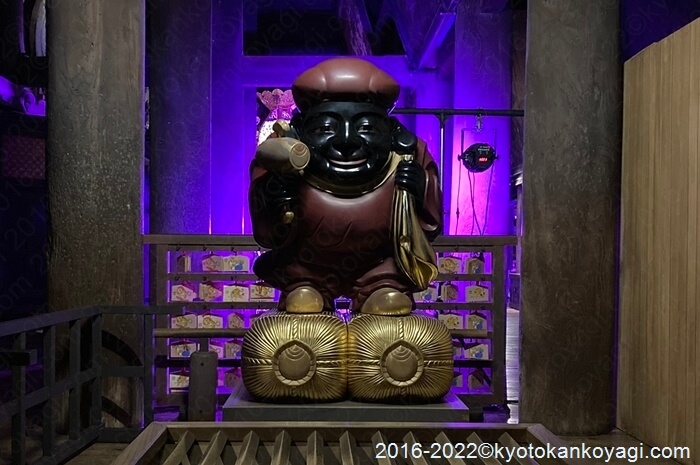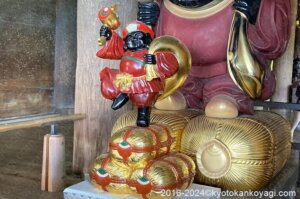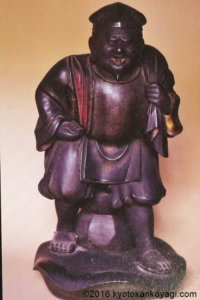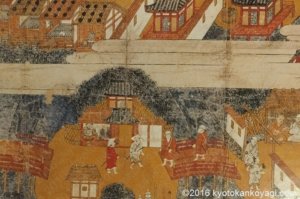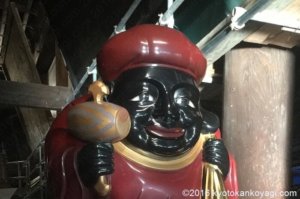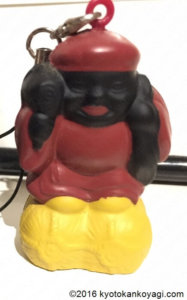Introduction
A new figurine of Daikokusan appeared!!
Passing through Todorokimon gate of Kiyomizudera, we catch a glimpse of a Kawaii statute. He is Shusse Daikokuten, a Buddhist deity who welcomes the visitors of the temple for over 500 years. We call him Daikoku-san with respect. In this post, let us learn who he is.
Who is Shusse Daikokuten? 出世大黒天とは?
Daikokuten
Daikokuten is one of the seven deities who bring us fortunes, especially wealth. He is originaly a Hindu deity Mahakala, aka Shiva adopted by Buddhism.
Mahakala means “great black one.” In Japanese, it is translated as “Daikoku.” “Ten” of Daikokuten is a suffix for a guardian deity of Buddhism.
In Shinbutsu Shugo, Daikokuten fuses with Okuninusu no Mikoto because Okuni (大国)can be pronounced as “Daikoku.”
As Daikoku-san of Kiyomizudera, Daikokuten usually smiles but some of his statues are angry because he is originally a deity of creation and destruction.
The ability to create made him a deity of prosperity and fertility. The fertility was so emphasized he was known for a guardian of kitchen.
Shusse
Shusse means promotion (in career) in Japanese. As described before, he is a deity of prosperity. Daikoku-san of Kiyomizudera is well-known for his Goriyaku (Good fortunes deities gave us) of Shusse.

In the next chapter, make sure his other Goriyaku respectively.
Goriyaku of Shusse Daikokuten 出世大黒天のご利益
Economic fortune 財運
Take a look at the hummer he has. It is Uchide no Kozuchi. With one shake, we could have anything we need. In Japan, it is a symbol of economic fortune and wealth.
He has a bag in his left hand. It contains treasures.

In Gion Ebessan, a priestess shakes a Uchide no Kozuchi for us. And Jishu shire, we can shake a Uchide no Kozuchi by ourselves.
Fertility 五穀豊穣
Uchide no Kozuchi also gives us fertility in cultivation. He is on two Komedawaras. Komedawara is a container of rice and the symbol fertility.
Enmusubi 縁結び
Goen is a bond. As indicated before, he fuses with Okuninushi. Okuninushi is a Shinto deity who give us bond among persons. Love-seekers want his Goen.
Daikoku-san welcomes us over 500 years 500年前から参拝者をお出迎え
Today, Daikoku-san is located in Kiyomizudera but he used to be in a small temple in the island of Kamo river. The picture describes Daikoku-san in the 16th century.
The island is on the tip of the secular world. The inside of the white walls is the sacred world. The visitors prayed for Daikoku-san and got into the other world.
The statue was made in around 15th century. He is very beautiful because re-painted recently.
Amulet 大黒天お守り
Many Daikoku-san amulet is available in Kiyomizudera. And small “puni-puni” Daikokusan is strongly recommended. Small one is 350 JPY and large one is 900 JPY.

I can’t translate “puni-puni.” I suppose cat beans has a “puni-puni” touch.
About Kiyomizu-dera 清水寺基本情報
Access to Kiyomizu-dera 清水寺へのアクセス
The nearest bus stop is Kiyomizu Michi bus stop. It takes about 20 minutes to Kiyomizu-dera.

